
The words on the World War II poster at left were taken from an address to the nation made by President Franklin D. Roosevelt on December 9, 1941, only two days after the attack on Pearl Harbor.
The American people responded as they had never done before nor have since.More than sixteen million Americans served in the Armed Forces of the United States and America became the "Arsenal of Democracy."
American factories switched from building their normal products to producing every sort of war materiel.The companies that owned those factories advertised their products and patriotism in many war-time publications.Just about every magazine ad featured, or at least made reference to, the war.
 Even the lesser-known China-Burma-India Theater caught the advertiser's eye.Below are some World War II era magazine ads related to the CBI Theater and also some other interesting advertising.
Even the lesser-known China-Burma-India Theater caught the advertiser's eye.Below are some World War II era magazine ads related to the CBI Theater and also some other interesting advertising.Click on any image to view enlarged in full window
Scroll down or click any red-white-blue stripe below for next section



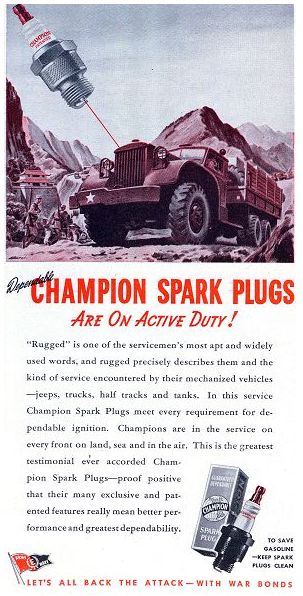 |
At right is an ad for Champion Spark Plugs. While it makes no specific reference to CBI, it does mention "rugged" trucks at work on all fronts. The illustration at the top of the ad (and shown below) depicts a U.S. Army truck climbing a steep grade, perhaps on the Burma Road.Other trucks can be seen on a road in the background.Also in the background are high mountains, maybe the Himalayas.What appear to be Chinese soldiers and a mountain temple are next to the truck.
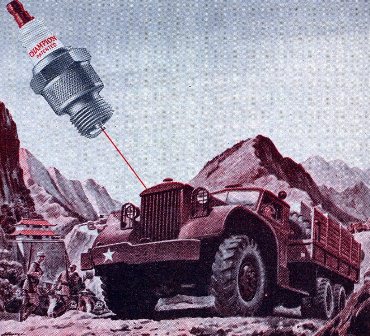 |

 |
China is specifically mentioned in this AC Spark Plug advertisement.
Click on the image of the ad and take a closer look...


There's no mistaking the fact that this one is about the CBI as the Burma Road is the featured subject.The top of this B.F. Goodrich ad contains a photo of the famous 21 Curves at Annan, China (sometimes called the 24-zig).The curves however, are not actually part of the Burma Road, but a connected road.
The ad states:
"The Burma Road is an incredible highway. It's a 700-mile corkscrew twisting perilously through jagged mountain ranges. It's narrow, unpaved, 'Scratched out of the mountains with their fingernails,' as an American engineer described it. Yet this road with its treacherous curves and steep grades, often blocked by landslides and pockmarked by bombs, soon earned the name of 'China's Lifeline.'"
Many interesting photos of these curves exist, all from a similar angle.Apparently this photo was taken while there was no traffic on the road, as the trucks navigating the lower part of the curves appear to be drawn-in !
Click on the image of the ad and take a closer look...



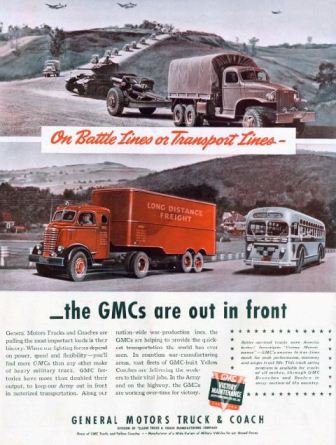 |
This GMC ad does not specifically mention CBI or the Burma Road, but trucks on a dirt road are shown in the upper picture. The lower picture in the ad shows a tractor-trailer truck. Compare it with an actual photo of trucks along the Burma Road (below).
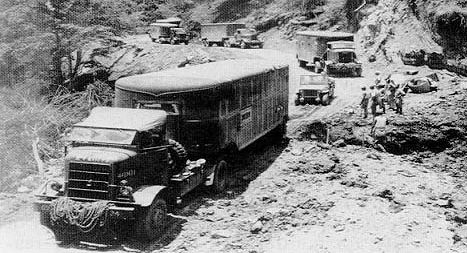 |


This ad is from after the war. Actually, OVER 50 YEARS AFTER THE WAR! It features Dodge Trucks and specifically mentions the Burma Road.
"The distinctive design first appeared on the T234 ¾-ton truck that Dodge built for the Chinese Army.(The truck was also known as the Burma Road truck.)"
 |

This one is self-explanatory...
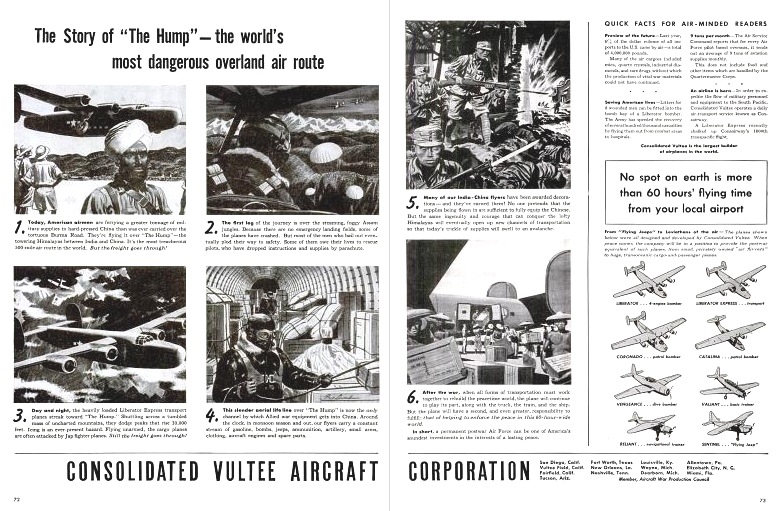

"Pan Am" Clippers saved China a century and rescued people from Burma...

Click on the image of the ad to take a closer look


Click on the image of the ad to take a closer look

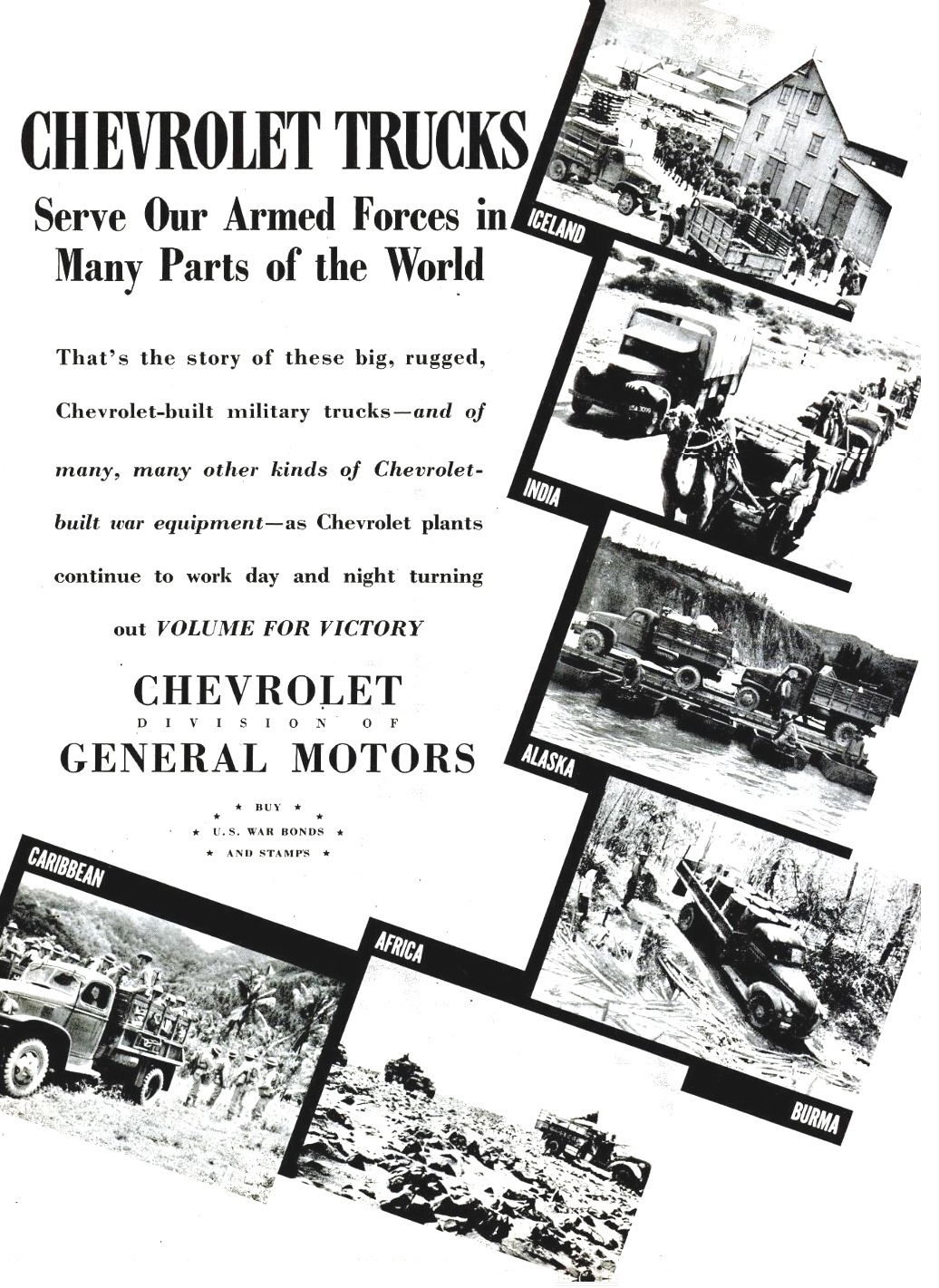
Chevrolet trucks serve in many parts of the world including India and Burma.
Click on the image of the ad and take a closer look...
 INDIA INDIA |
 BURMA BURMA |



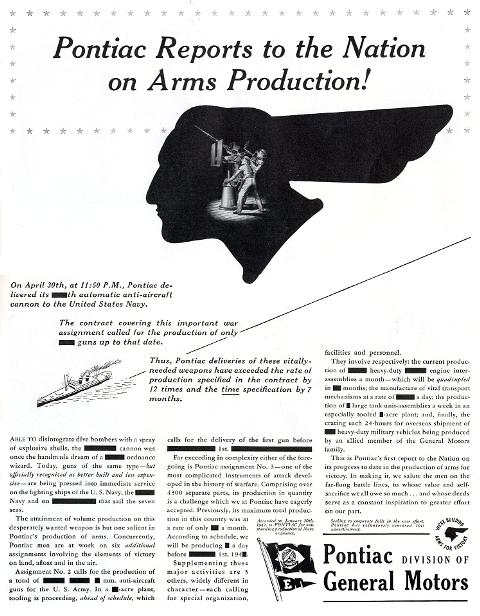 This ad is not related to CBI but interestingly illustrates what could be called "Censored Advertising."
This ad is not related to CBI but interestingly illustrates what could be called "Censored Advertising."It looks like Pontiac submitted the copy for the ad to a military censor who crossed-out any informationthat might be of help to the enemy. They then prepared the ad with the censored information blacked-out.
The result is doubly patriotic advertising: Pontiac is building arms for the war effort and also will not jeopardizethat effort by bragging about it in magazines.
In case the reader did not get the message, it was spelled out for them near the bottom of the ad:
"Seeking to cooperate fully in the war effort, Pontiac has voluntarily censored this advertisement."

 Here is another example of "Censored Advertising." This one apologized by indicating:
Here is another example of "Censored Advertising." This one apologized by indicating:"Sorry we can't be more explicit. Revelation of details might be of aid to the enemy... endanger American lives."
The censor was not as busy on this one as there are only two blacked-out items.

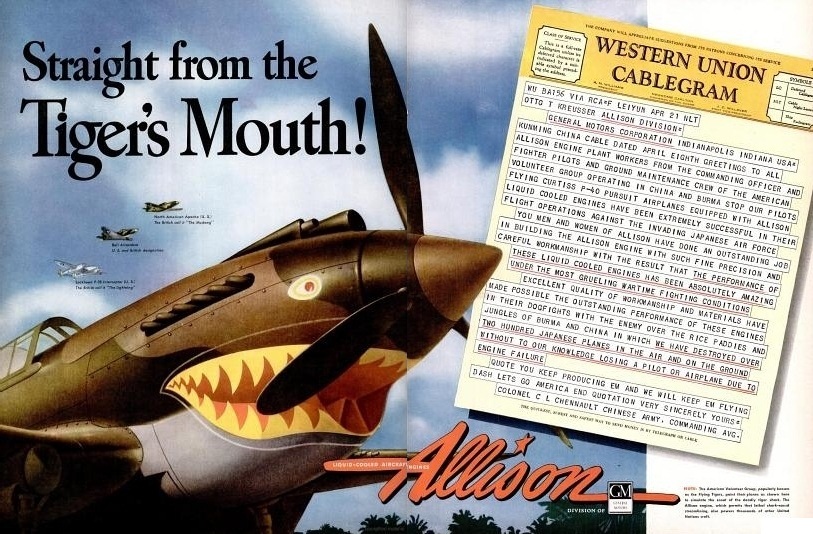
Click on the image of the ad to take a closer look, or to read the text of the cablegram... CLICK HERE

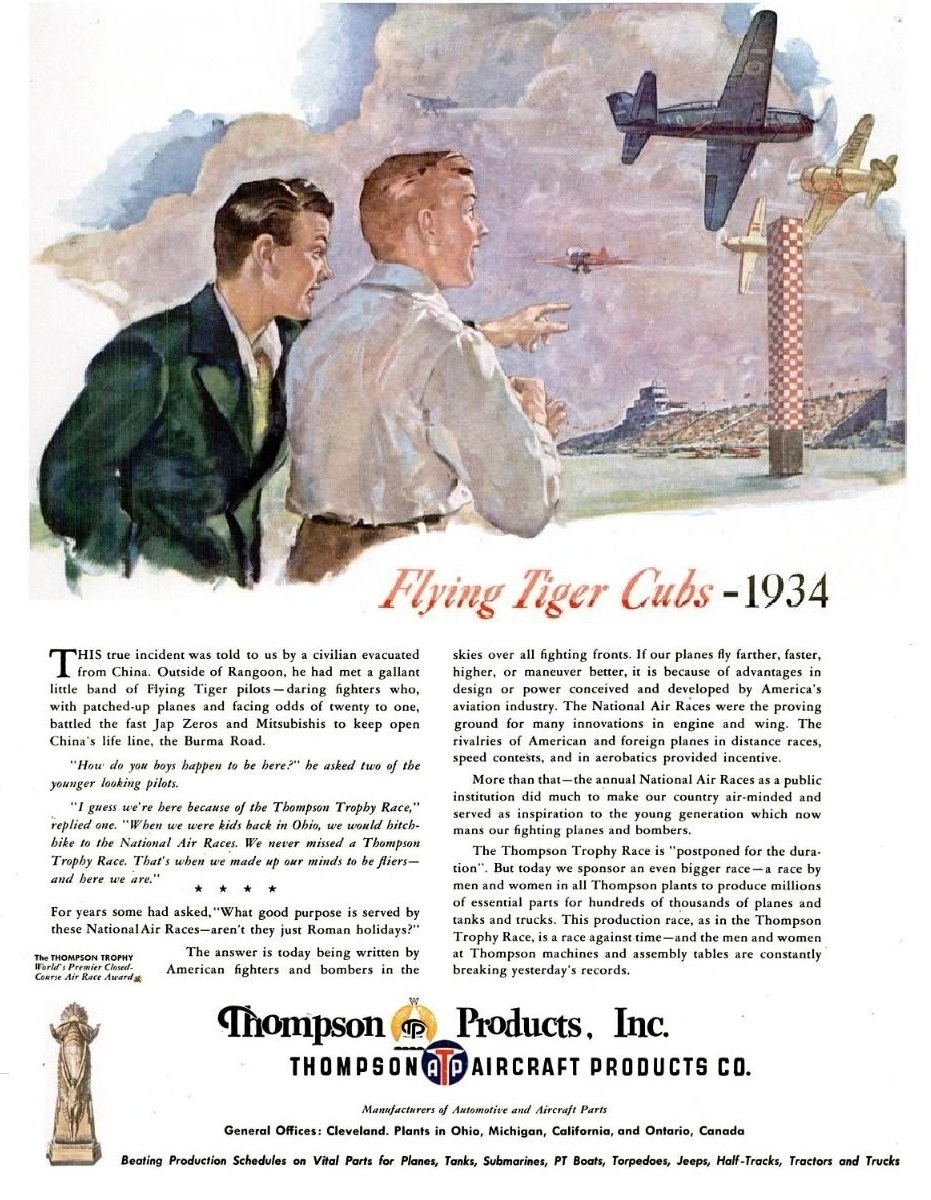 Thompson Aircraft Products also featured the Flying Tigers in this story of why one of them became a pilot.
Thompson Aircraft Products also featured the Flying Tigers in this story of why one of them became a pilot.Click on the image of the ad to take a closer look.

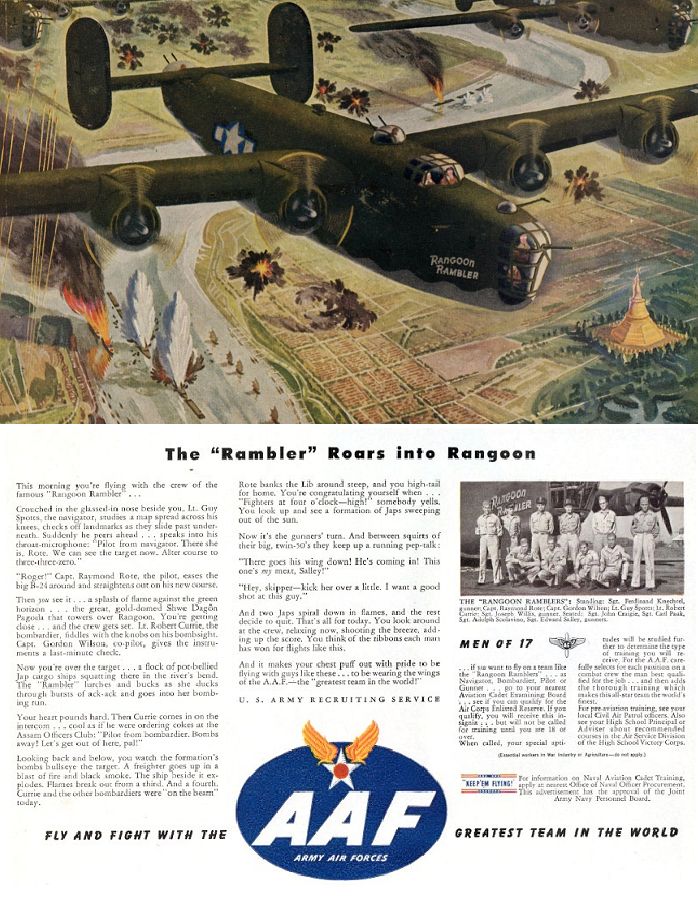 This ad from the U.S. Army Recruiting Services features a story of the "Rangoon Rambler" over CBI.It speaks of the adventure of a bombing run over Rangoon, Burma.Also included is the story of the crew of the B-24 Liberator.
This ad from the U.S. Army Recruiting Services features a story of the "Rangoon Rambler" over CBI.It speaks of the adventure of a bombing run over Rangoon, Burma.Also included is the story of the crew of the B-24 Liberator.Click text of advertisement to see re-created ad page.


The makers of the B-24 Liberator and C-87 Liberator Express placed a two-page ad about their aircraft in LIFE.
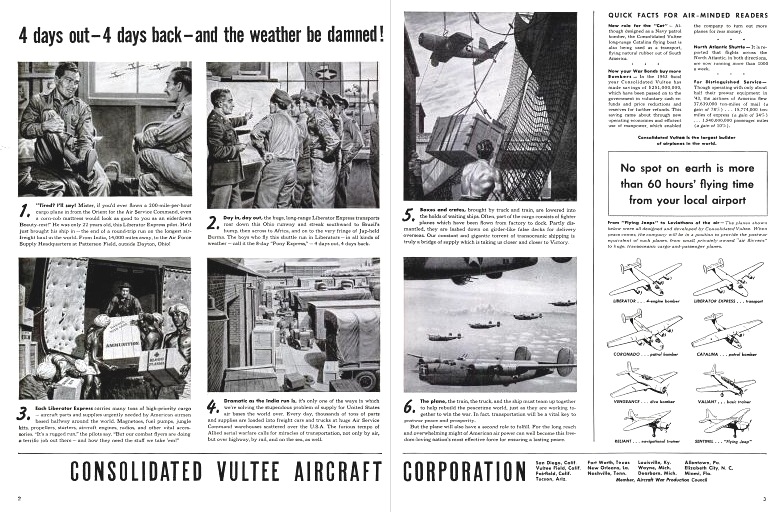


Peacemakers
By the time this Boeing advertisement appeared in the August 6, 1945 issue of LIFE, the B-29 Superfortresses had been flying from the Pacific islands of Tinian and Guam for quite some time.
But as the ad points out, they started in China, flying their own supplies over The Hump from India.
The B-29 "Enola Gay" dropped the first atomic bomb on the very date this issue was published.
Click on the image of the ad to take a closer look. 
Squibb Laboratories advertised their fight against malaria and typhus including in CBI areas
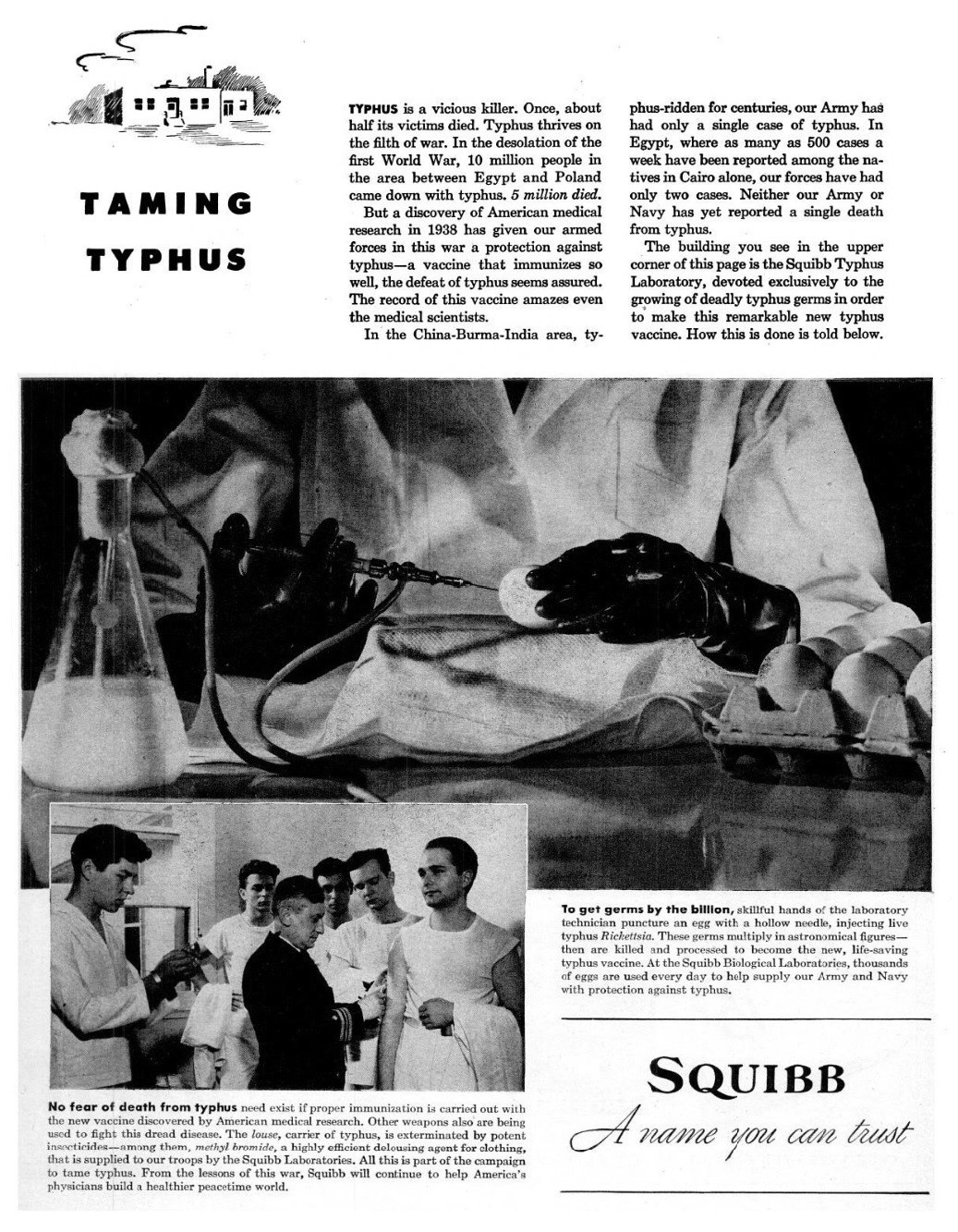

Click on the images of the ads to take a closer look.

 North American Aviation featured their B-25 Mitchell bomber in skip-bombing action over Burma in this ad from the February 5, 1945 issue of LIFE magazine.
North American Aviation featured their B-25 Mitchell bomber in skip-bombing action over Burma in this ad from the February 5, 1945 issue of LIFE magazine.They call them the "Burma Dental Clinic" but they were more famous as the "Burma Bridge Busters."

Click on the image of the ad to take a closer look.

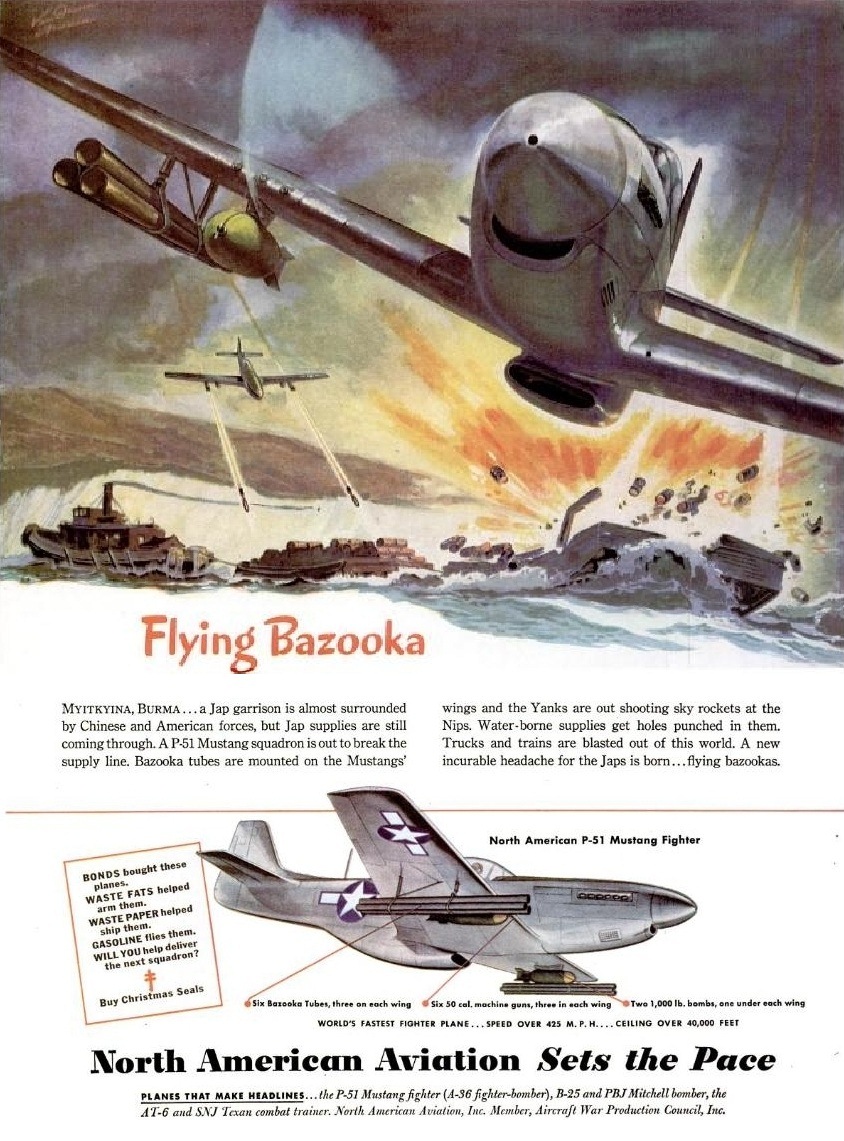
Flying Bazooka
Another ad from North American features their P-51 Mustang fitted with bazooka tubes in action over Myitkyina, Burma. The March of Time regularly reported news from all over the world. Here they feature India in their ad and news direct from New Delhi. At first glance it appears that Studebaker is advertising their Flying Fortress! Actually they are advertising the fact that they build Wright Cyclone engines for the Boeing B-17 bomber. Also shown are 6x6 military trucks.The trucks probably made it to CBI but the B-17's were mostly limited to use over Europe. Automobile manufacturers ceased car production and instead built things like airplane engines, trucks and tanks.It was not unusual for a company like Studebaker to build Wright engines for Boeing planes. Buick Powers the Liberator Here Buick advertises the fact that they build Pratt & Whitney engines for the Consolidated B-24 Liberator bomber.Many "Libs" saw service in CBI. The Cross Roads of the World include India in this ad from the Air Transport Association. The scene depicts a Curtiss C-46 "Commando" passing over a Douglas C-47 "Skytrain." Both planes were derived from designs for civilian passenger aircraft.Over 10,000 C-47's were built during the war.Just under 3,200 C-46's were built. Lionel Corporation, like many other small manufacturing companies, halted normal production and instead built necessary items for war.Lionel produced nautical items for the United States Navy. Lionel also introduced the so-called "paper train," a detailed set of cut-and-fold models of Lionel trains printed on cardstock that was notoriously difficult to put together. Advertised here is the fact that there were still some already produced trains at dealers and the 1942 catalog, which would have been printedbefore Pearl Harbor, was available for dreamers. The iconic Lionel Trains are still around, now mostly "Made in China." The Burma-Vita company was famous for its rhyming sayings (as in the ad at right) and for roadside signs placed in sequence along U.S. highways. Burma Shave brushless shaving cream was introduced in 1925 and was popular during World War II.Eventually declining sales caused it to disappear from store shelves in the early 1960's. Formed in 1942 as an auxiliary unit of the Army, the Women's Army Corps became a full branch in 1943, intended to free-up men for combat duty.It did just that, making it not so popular with those men. Over 150,000 women served in the U.S. Army during the war, most in the U.S., although many did go overseas. The "WAC" featured here has two brothers in the Army and the man she is going to marry is a bomber pilot in Burma. Hump pilots got a lift when the more reliable Curtiss C-46 Commando transport entered service in CBI. Like most airplane manufacturer's ads, this one also features an "after the war" theme. "Victory Mail" was developed to save size and weight transporting mail to and from overseas GI's. V-mail correspondence was on small letter sheets that would go through censors before being photographed and transferred to negative microfilm. Upon arrival to their destination, the negatives would be blown up to 60% their original size and printed. According to the National Postal Museum, "V-mail ensured that thousands of tons of shipping space could be reserved for war materials. The 37 mail bags required to carry 150,000 one-page letters could be replaced by a single mail sack. The weight of that same amount of mail was reduced dramatically from 2,575 pounds to a mere 45." Warner Bros. answered that question with this ad for Objective, Burma!. This Curtiss-Wright ad featured the "epic picture of gallant fighting men and their stout-hearted Curtiss P-40's." The plane was known as the Warhawk by the U.S. Army but later models were also known as the Tomahawk and Kittyhawk.A total of 13,738 were built, flown by 28 different Allied air forces as indicated in the ad. Production of the plane had already ceased by the time this March 1945 ad appeared in LIFE magazine. Peoria, Illinois was where Caterpillar bulldozers were built. "Little Peoria" on the Ledo Road in Burma is where they were serviced. In need of skilled workers to maintain and repair the equipment being used in India and Burma, the U.S. Army Corps of Engineers called on Caterpillar. The 497th Engineer Heavy Shop Company was the first unit in American history organized by a manufacturing company and manned primarily by its own employees. A 1932 Plymouth still running as a taxi in Bombay, India, is featured in this 1944 ad to illustrate that Plymouth builds great cars. They go on to say that three-fourths of all supplies flown over The Hump went in Curtiss Commandos.
Click on the image of the ad to take a closer look. 
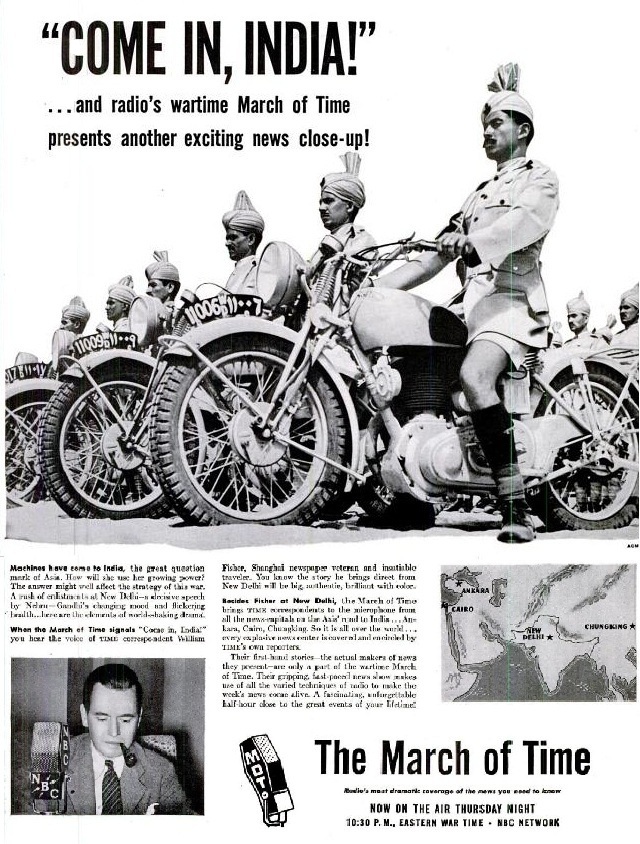
The radio was the quickest way to get news of the war.Many living rooms featured a radio the way today's do televisions.
Click on the image of the ad to take a closer look. 
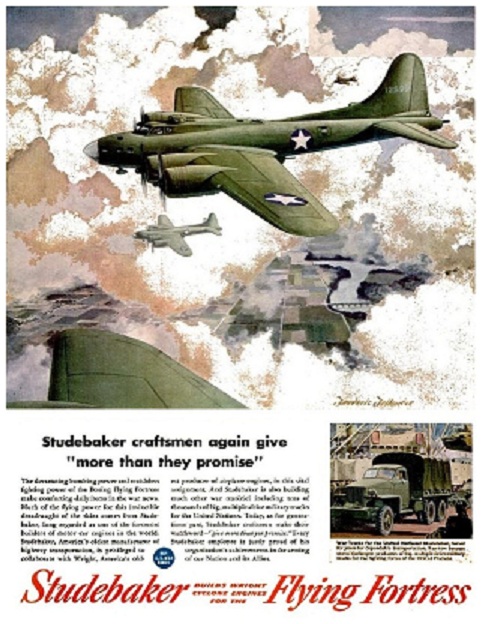 Studebaker Flying Fortress ?
Studebaker Flying Fortress ?
Click on the image of the ad to take a closer look. 
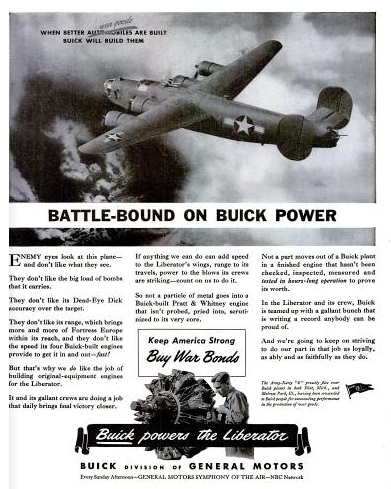
Click on the image of the ad to take a closer look. 
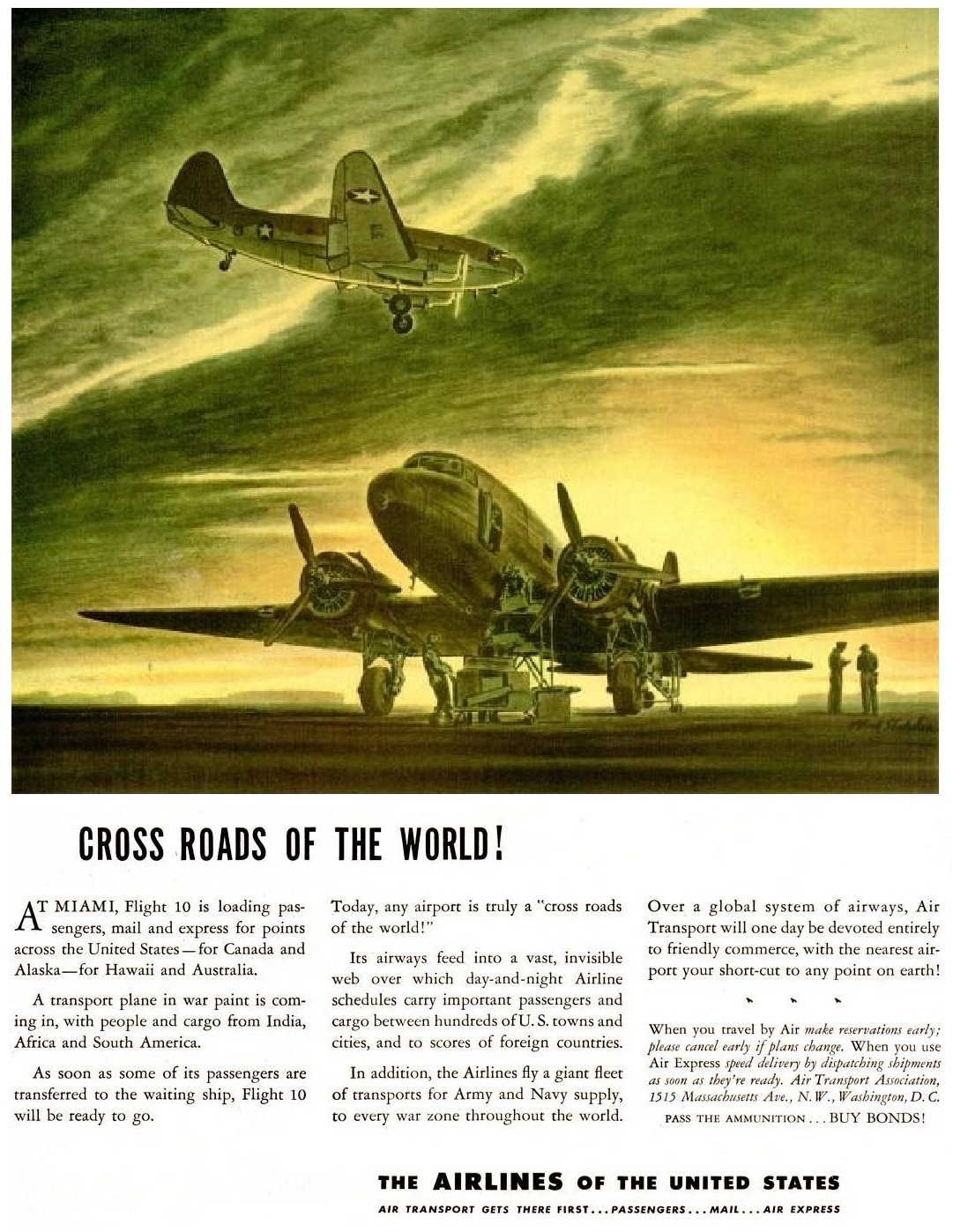
Click on the image of the ad to take a closer look. 
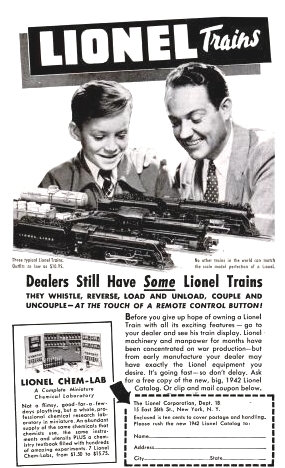
Plastic and metal were needed for war materials so there was none to make toy trains.
Click on the image of the ad and take a closer look... 
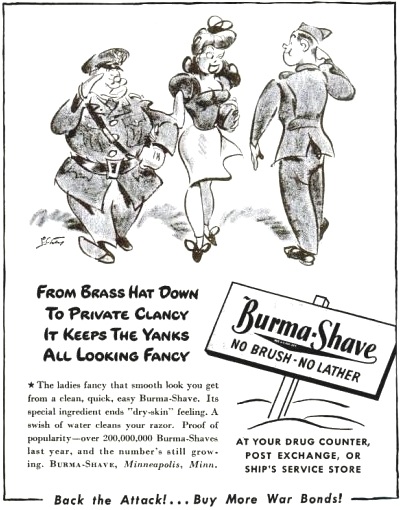
Besides the obvious name connection, Burma Shave was said to be made from ingredients having come "from the Malay Peninsula and Burma."
Click on the image of the ad and take a closer look... 
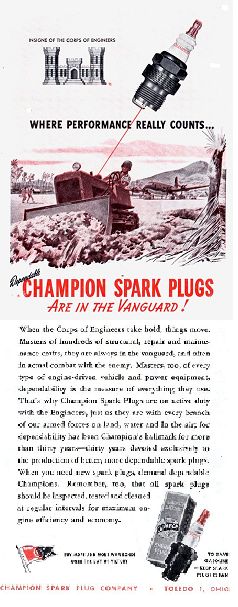
Another advertisement for Champion Spark Plugs.This one features the Corps of Engineers and a bulldozer at work on an airfield.

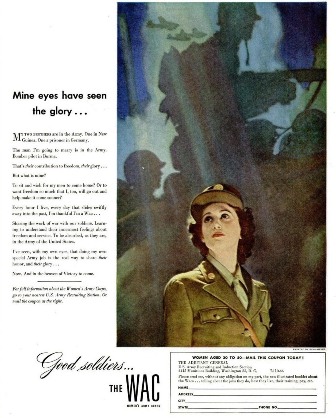 Women's Army Corps.
Women's Army Corps.
Click on the image of the ad to take a closer look. 
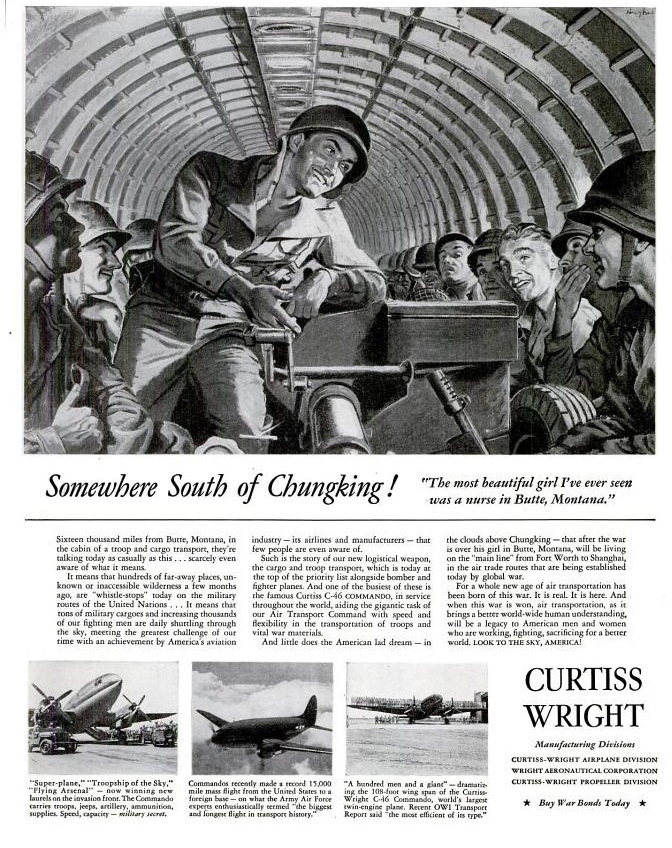 Somewhere South of Chungking!
Somewhere South of Chungking!
Click on the image of the ad to take a closer look. 
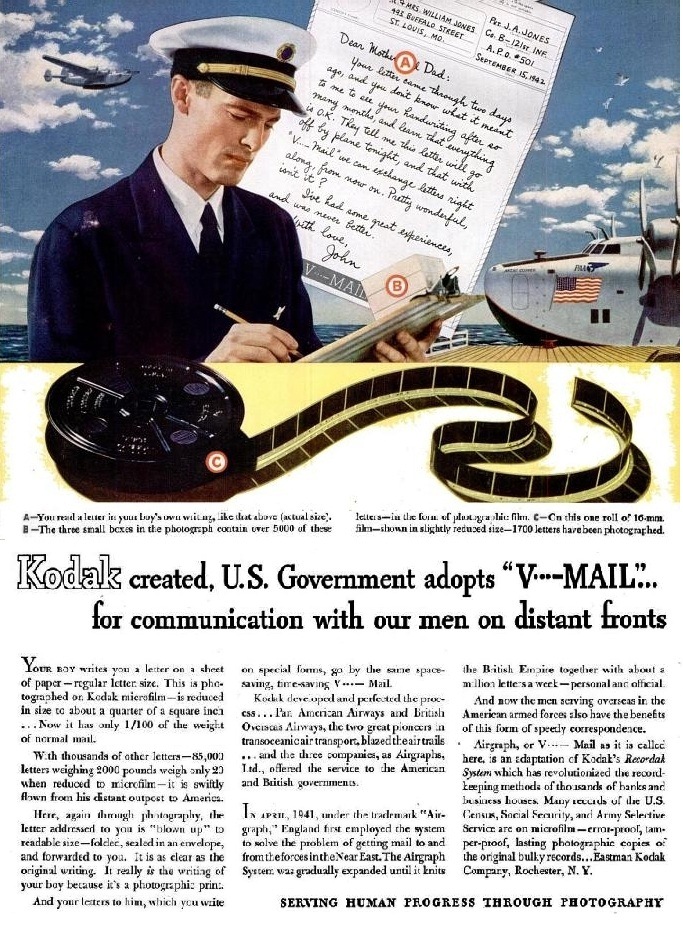
Kodak created V-Mail
Click on the image of the ad and take a closer look... 

Filmmaking was one of the few industries that continued almost uninterrupted during the war.In fact, the war gave movie-makers timely subject matter.
This ad for Motorola Radio features the 1945 Warner Bros. movie, "Objective Burma" starring Errol Flynn.No doubt based on some facts, the movie was fictional and glorified the American effort in Burma, while making almost no mention of larger British contributions. The movie summary:
The movie summary:
A group of men parachute into Japanese-occupied Burma with a dangerous and important mission:to locate and blow up a radar station. They accomplish this well enough, but when they try to rendezvous at an old air-strip to be taken back to their base, they find Japanese waiting for them, and they must make a long, difficult walk back through enemy-occupied jungle.
Not only does this ad mention the radios produced for the war effort, but those waiting to be produced for consumers after the war.By 1945 the theme of most printed advertising had shifted from "Back the attack" to "After the war..."
Click image at left to view text of ad or
click movie poster at right for more about the movie.
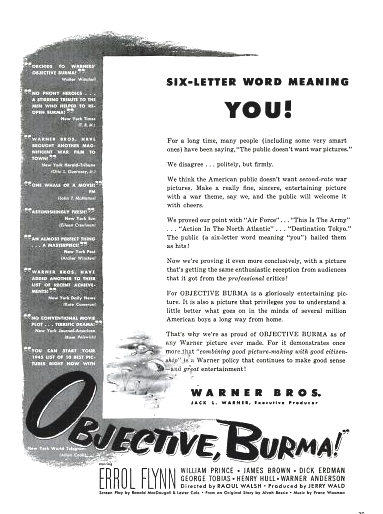
Newspapers and radio were full of war news.Many people headed to the movies to escape the war for a while.So who would want to see a "war picture?"
Click on the image of the ad and take a closer look... 

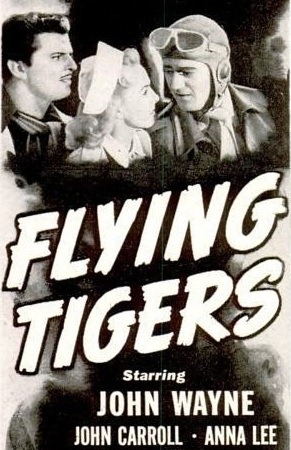
"The Duke" starred in many World War 2 related films including this lesser-known one from 1942 about the American Volunteer Group "Flying Tigers."
Click image at left to view text of ad.
Click image at right for more about the movie.
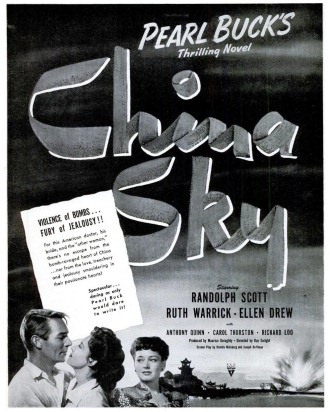
RKO Radio Pictures advertised their new movie based on the book by Pearl Buck.
Click on the image of the ad and take a closer look... 
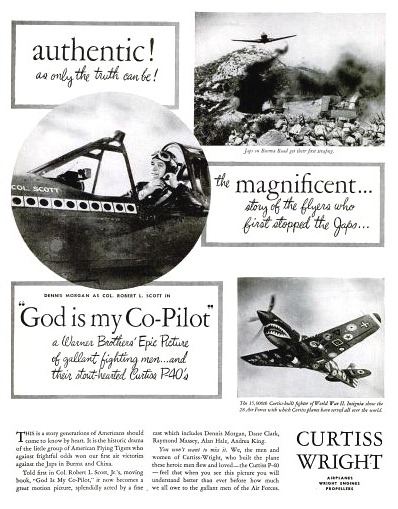
Another movie about the Flying Tigers was based on Col. Robert Scott's book God is my Co-Pilot.
Click on the image of the ad and take a closer look... 

This 1943 advertisement in LIFE by Coca-Cola says that "Coke" is a way to say "We are friends" to the Chinese.It shows American Flying Tigers and Chinese drinking Coca-Cola.The ground crewman at left seems to be indicating three "kills" for the pilot and his shot-up plane in the background.
It also explains the relatively new nickname "Coke" for "Coca-Cola" by saying:It's natural for popular names to acquire friendly abbreviations. That's why you hear Coca-Cola called "Coke".
Click on the image of the ad and take a closer look... 

This advertisement in LIFE by Caterpillar features Little Peoria on the Ledo Road.
Click on the image of the ad and take a closer look...

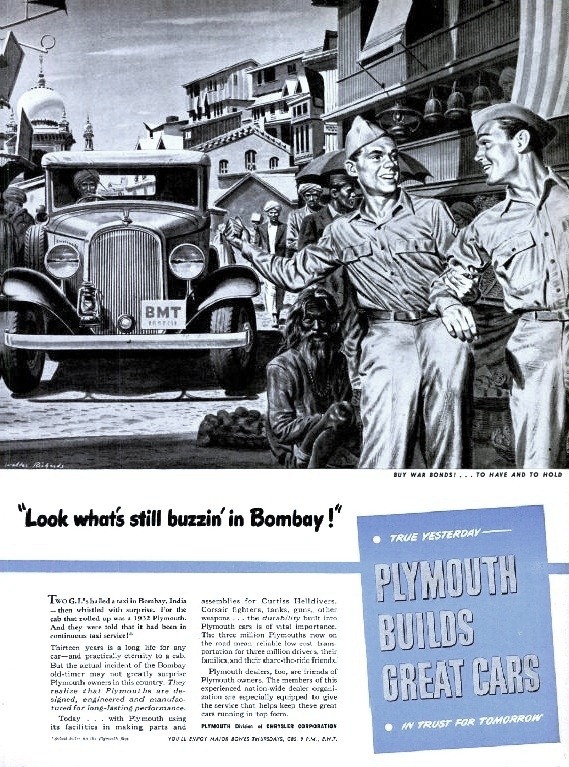
"Look what's still buzzin' in Bombay!"
It's not often that an ad for new cars features a picture of one that's twelve years old, but that's what Plymouth did here.
Click on the image of the ad and take a closer look... 

An Amazing Story of Air Transport at War
Curtiss-Wright advertised the fact that their C-46 Commandos cross The Hump every 15 minutes.
Click on the image of the ad and take a closer look... 

Click on the image of the ad to take a closer look

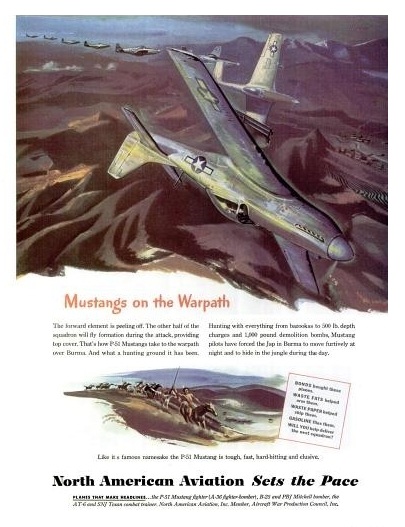
Mustangs on the Warpath over Burma
Another beautifully illustrated North American Aviation ad featuring their P-51 Mustang in action over Burma.
Click on the image of the ad and take a closer look...


The reference to the Flying Tigers is obvious; the connection to Texas citrus fruits, not so much.This label adorned boxes of citrus fruit.

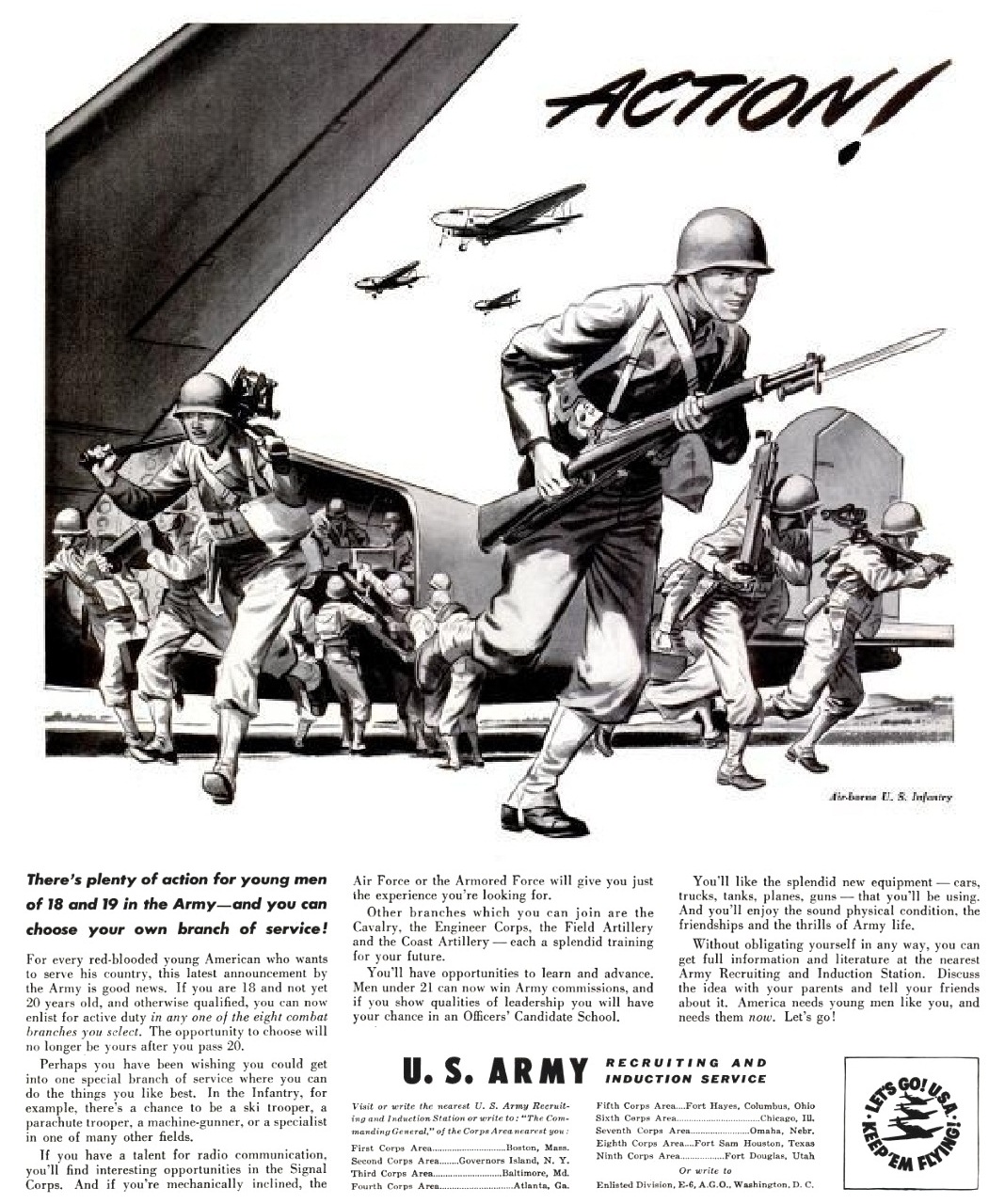
The U.S. Army Recruiting and Induction Service offered ACTION! and how you could choose your own branch of service as long as you "signed-up" before age 20.
Click on the image of the ad and take a closer look...

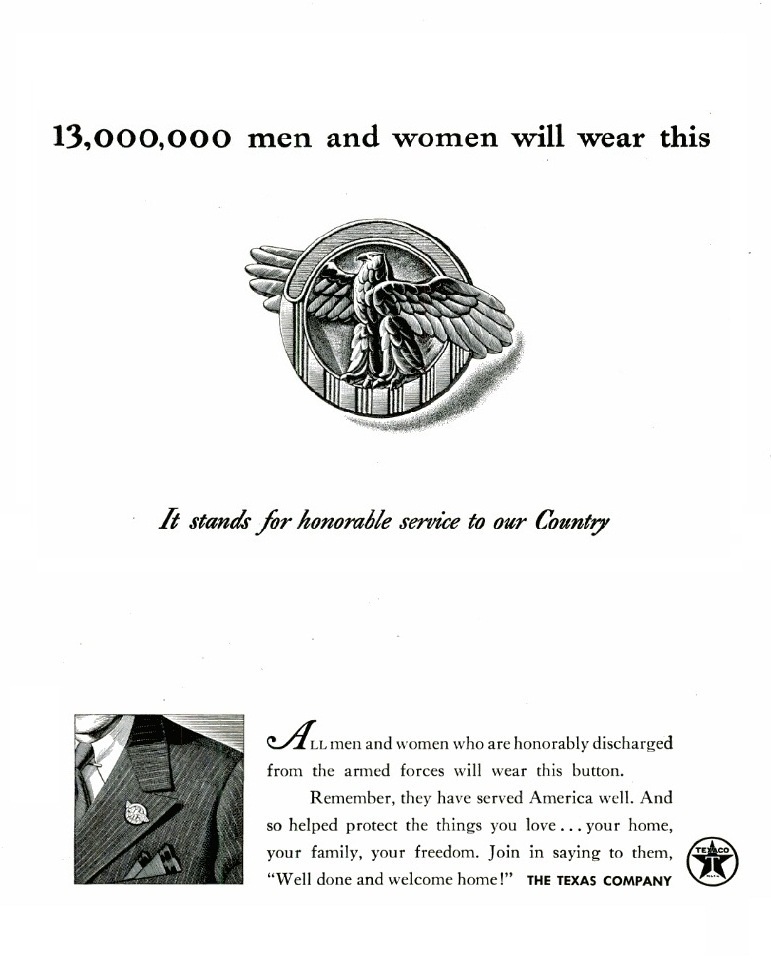
Well done and welcome home!
On this page The Texas Company, better known as Texaco, featured the World War II Honorable Service Lapel Button commonly know as the "Ruptured Duck." This button was issued to military personnel (actually about 16 million) when they were honorably discharged and is indicated on their DD-214 discharge form by the term "Lapel button issued." The award was commonly called the "Ruptured Duck" by veterans because the eagle faced to the right hand side, which was the same direction that doctors instructed inductees turn their heads when told to cough during a examination for rupture. The ruptured duck term became slang to refer to discharged veterans wearing the award and also someone in a hurry, since discharged veterans were in a hurry to return home. The button was also embroidered in gold colored cloth and sewn above the right breast pocket of the veteran s uniform allowing them to wear their uniform for up to a month after discharge to declare that they were not AWOL.Discharged veterans were not issued civilian clothes. During the war it was rare for the American public to see bodies of American soldiers in newspapers or magazines. This is one of the few exceptions, and the message here is clear - he gave everything for freedom.
Click on the image of the ad and take a closer look... 
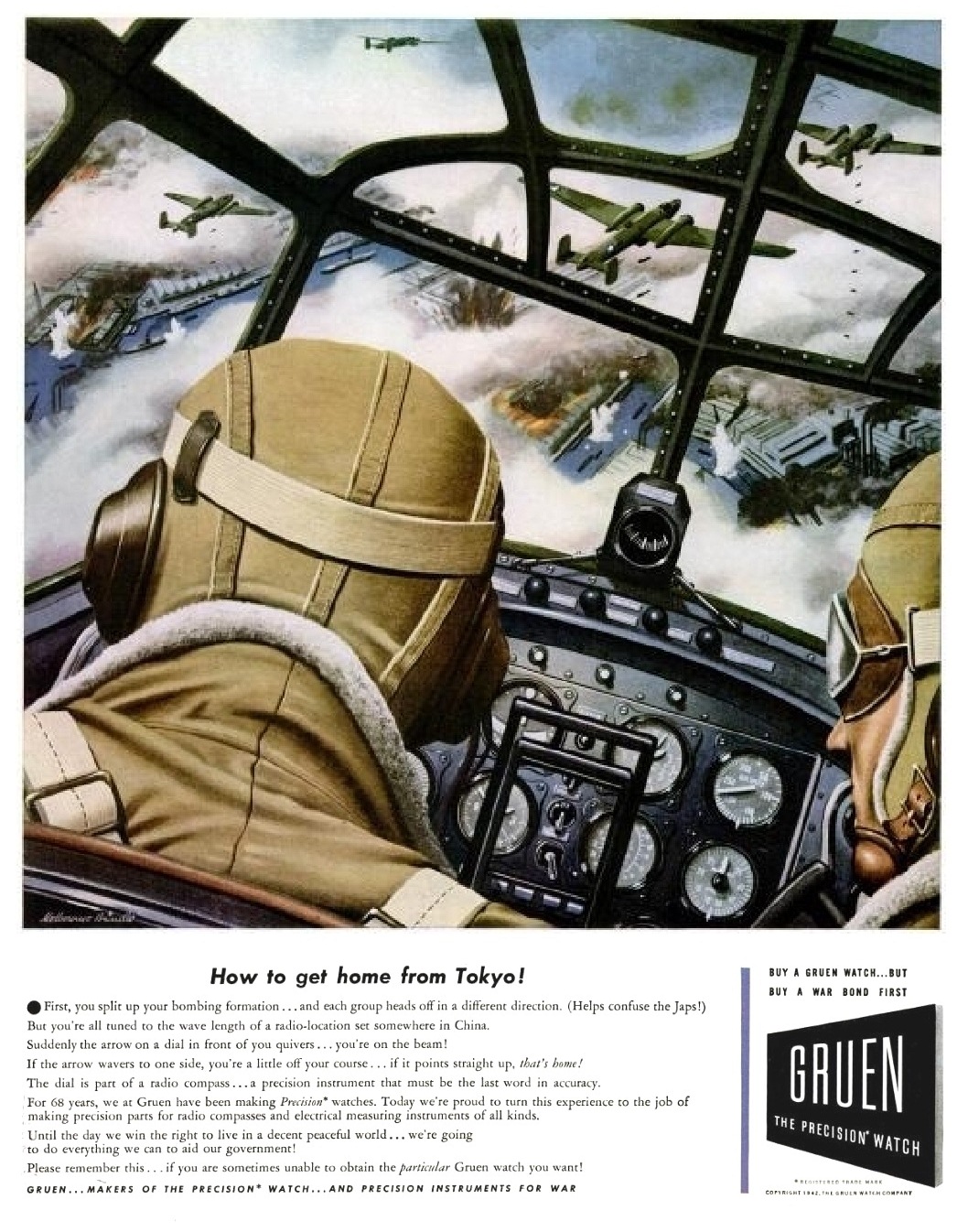
How to get home from Tokyo!
Gruen watches featured this ad about using their precision radio compass to follow a location beacon in China.
It also urges you to "Buy a Gruen Watch... But Buy a War Bond First."
Click on the image of the ad and take a closer look...
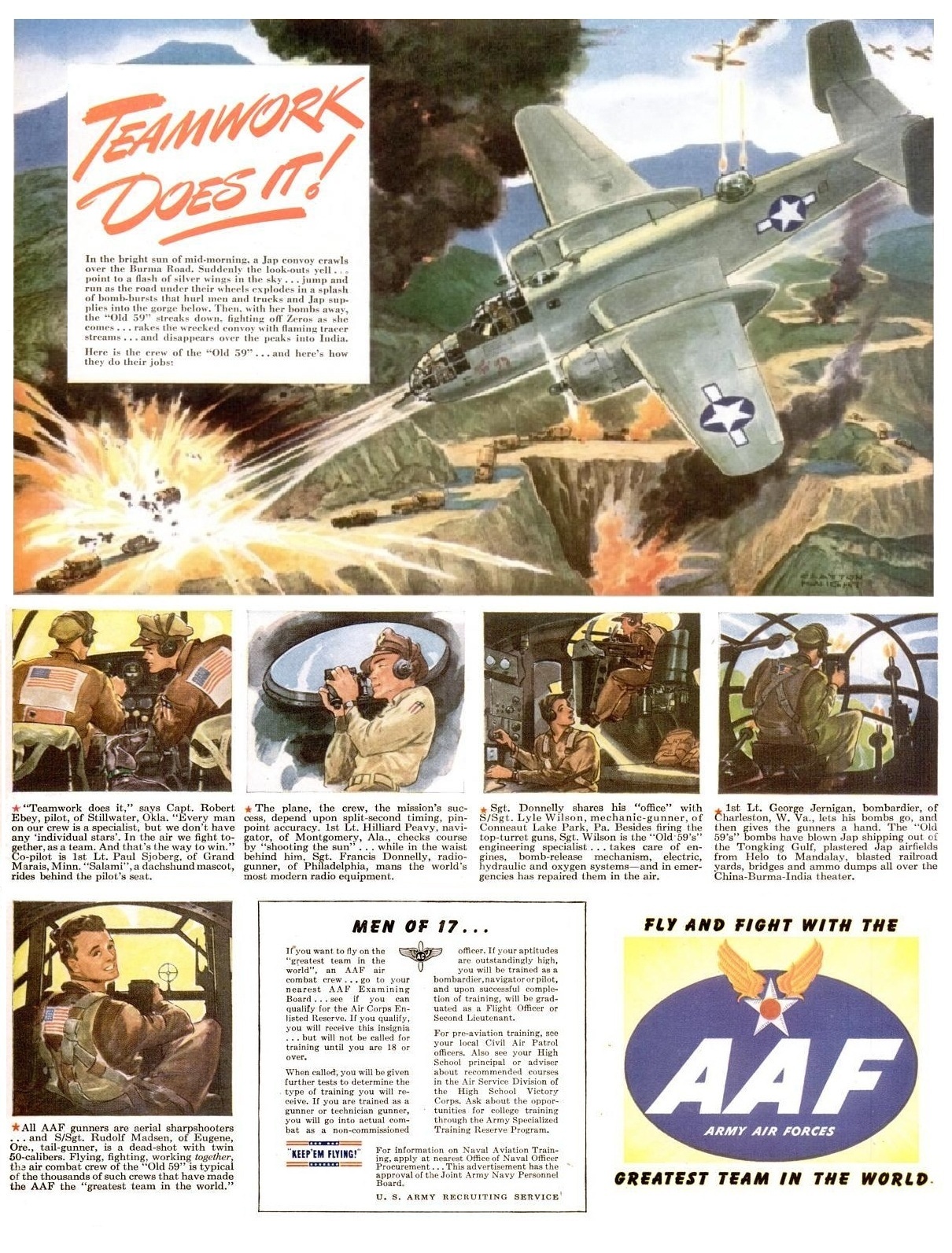
Teamwork Does It!
Another ad from the U.S. Army Recruiting Service, this one emphasizing teamwork of the Army Air Force crew in action over Burma.
Click on the image of the ad and take a closer look . . .
To see a re-creation of the ad . . . CLICK HERE

Americans Build World's Longest Pipeline
Founded in 1924, the Ethyl company was formed to produce and sell tetraethyl lead (TEL), an anti-knock gasoline additive.
They advertised their product using the long pipeline being built to China:
"Runing all the way from Calcutta up the Brahmaputra Valley through Assam into North Burma, the world's longest pipeline is now delivering tens of thousands of gallons of gasoline for airplanes and motor vehicles at American installations in the North Birma-Assam combat area."
Click on the image of the ad to take a closer look and read all about it...

This is a public service announcement, rather than an advertisement,as it addresses the reality of war like no advertiser would.
Click on the image of the ad and take a closer look
Click on the Gold Star Flag to learn about it





Advertising CBI
FOR NON-COMMERCIAL HISTORICAL REFERENCE ONLY
Copyright © 2005 by Carl W. Weidenburner
MORE WORLD WAR TWO ADVERTISING
TOP OF PAGE ABOUT THIS PAGE CLOSE THIS WINDOW
Visitors
Since February 12, 2005